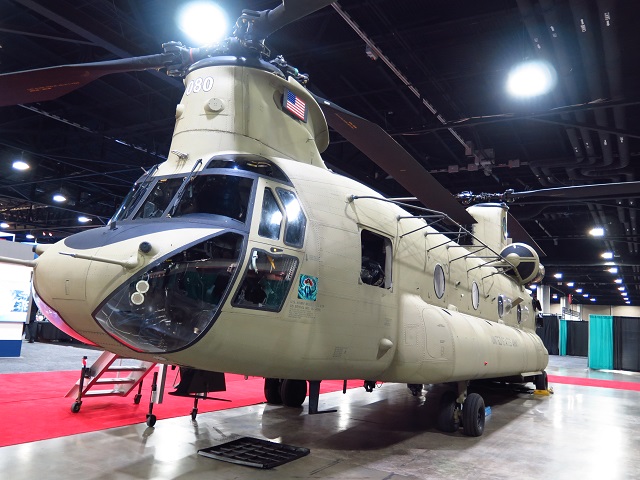Boeing’s vice-president of heavy-lift helicopter programmes Steve Parker, says the CH-47 Chinook is well positioned to compete for international orders against the Sikorsky CH-53K King Stallion as the two face off in Germany, which is looking to replace its outdated fleet of CH-53Gs beginning in 2022. Barring any potential Bell-Boeing V-22 offer, Luftwaffe officials say the CH-47 and CH-53K are most suitable.
Lockheed Martin-owned Sikorsky now has two developmental CH-53K aircraft flying in West Palm Beach, Florida and recently secured funding from the US government for Lot 1 long-lead parts.
The US Marine Corps wants 200 CH-53Ks to replace the CH-53E, with the first operational squadron due by 2019. The King Stallion is designed to lift 12.2t (27,000lb) over 110nm in hot, high conditions.

Sikorsky CH-53K conducts first external load test on 19 April
Sikorsky
Parker, who leads the H-47 programme in Philadelphia, Pennsylvania, says the CH-53K will be a “very good helicopter” but it is arriving late and is meant for niche roles, whereas the Chinook has a proven combat record and delivers on time and to the customer’s specifications.
Boeing most recently signed Chinook deals with Turkey, India and the Netherlands and added 37 more orders to its backlog in the past 10 months, with just 18 contract options remaining on its US Army multi-year CH-47F contract that was established in 2013.
“In India, we beat the Russians,” Parker said at an Army Aviation Association of America symposium in Atlanta, Georgia on 29 April. “We beat the Russians on price, on acquisition, [and] we beat the Russians on the price of support. We’re up against the Europeans at all times, we’re up against American products.”
Asked if he was concerned about the CH-53K snatching orders in the 2020s when Boeing will be trying to bridge a production gap between the US Army's CH-47F purchase and the future Block II Chinook variant, Parker says: “It’s up at the very high end from a heavy-lift perspective and that’s a very niche market with certain customers with a very niche need. I think when you look at the very low risk, low cost and the capabilities that the Chinook provides, I’ll take that fight any day of the week because I think the Chinook is very well positioned.”

Boeing CH-47F Chinook dubbed "Cracie" on display at AAAA symposium 2016 in Atlanta, Georgia
James Drew/Flightglobal
Approximately 100 legacy D-models remain in the US Army's inventory as it transitions to the F-model and full divestment is expected by 2019, says the service's chief of cargo helicopter programmes, Col Rob Barrie.
Boeing is currently preparing for the Block II Chinook development programme and remains on track to conduct preliminary flight tests of the Advanced Chinook Rotor Blade sometime in the fourth quarter of this year.
Looking longer term and beyond the Block II model, the Army is thinking about re-engining the Chinook in a similar way to how it plans to replace the Sikorsky UH-60 Black Hawk and Boeing AH-64 Apache T700-series engine with a 3,000shp-class type in the mid-2020s via the $10 billion Improved Turbine Engine Programme (ITEP). The Chinook is powered by two Honeywell T55s.
“As we designed all of the changes we’re talking about in Block II, it was in anticipation of a future engine,” says Barrie, who notes that the next propulsion system could be derived from technologies matured under the Future Affordable Turbine Engine (FATE) programme that was won by GE Aviation. “On the order of 7,500hp-class engine is something that we would look at for a potential Block III [Chinook].”
The Army plans to continue operating the H-47 type past its 100th anniversary in the 2060s as it transitions to Future Vertical Lift.
Source: FlightGlobal.com



















